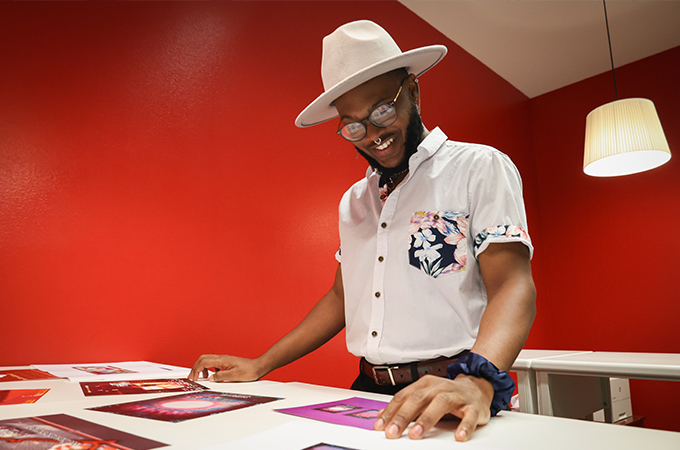Coming from a family of medical personnel, David Hazward ’22 grew up thinking he would become a doctor because he wanted to help people. But when a high school art teacher introduced him to the field of graphic design, Hazward realized he could make a difference in another way—by amplifying voices through art and design.
“Graphic design is everywhere, and it influences everything,” he says, noting that he was a creative kid who spent long afternoons at his local library in Beaumont, California, sitting at tables and drawing. “Nowadays, we’re so immersed in technology. Graphic design can help accentuate causes and issues that people care about.”
For him, this means raising awareness of the plight of marginalized communities. As Black Student Union president, Campus Diversity and Inclusion (CDI) multicultural intern, and a member of the Black Student, Faculty, Staff, Administrators, and Alumni Association (BSFSAA), Hazward spends much of his time planning, promoting, and facilitating events for students on the University of Redlands campus. He even says there’s a running joke that he lives in CDI because he usually can be found somewhere in Hunsaker University Center.
Over the course of his involvement, he has designed posters and other material for events and helped bring artists of color to campus to engage with students. Ahead of the recent inaugural Juneteenth event, he helped compile a catalog of local Black-owned businesses called The Black Pages: A Modern Greenbook for the Inland Empire.
Historically, The Negro Motorist Green Book was a published travel guide listing hotels, restaurants, gas stations, and other establishments where Black people would be safe from discrimination and violence in the segregation-era South. Taking this idea and applying it to the 21st century, Hazward and other University community members compiled a 10-page booklet of medical offices, barber shops, bookstores, and other businesses where students of color will feel safe and understood.
“Having grown up in the Inland Empire, I was always surrounded by people of color and frequented Black-owned businesses,” says Hazward, who savored the experience of getting in touch with local Black entrepreneurs to include in the book. “Now, new students will be able to easily find a place to get their hair done, among many other services.”
Hazward, who was known as an introvert as a teenager, says that, just a few years ago, he wouldn’t have been able to imagine himself being so involved on campus. While many members of the campus community have encouraged his personal and professional growth, he credits CDI Assistant Director Peter Tupou with much of his success.
“Peter was one of the first people I met when I came to Redlands,” he says. “I continued to interact and work with him and getting to do that continues to inspire me.”
Hazward looks forward to using his graphic design skills and work experience to help nonprofit organizations with art and other media coordination in the future. If he’s learned anything during his time at Redlands, it’s the value of knowing others feel included and heard.
“What I enjoy most is seeing people walk into Hunsaker and watching them leave later with a smile on their face,” he says. “The people I work with here and the variety of events we hold speak to the diversity of campus. We all support each other.”
Learn more about studying graphic design or diversity, equity, and inclusion initiatives at the U of R.






